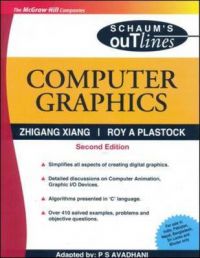
Computer graphics
Course Objectives:
The main objective of this module is to introduce to the students the concepts of computer graphics. It starts with an overview of interactive computer graphics, two dimensional system and mapping,then it presents the most important drawing algorithm, two-dimensional transformation;
Clipping, filling and an introduction to 3-D graphics.
Course Description and Purpose:
Basic principles and techniques for computer graphics on modern graphics hardware. Students will gain experience in interactive computer graphics using the OpenGL API. Topics include: 2D viewing, 3D viewing, perspective, lighting, and geometry. Prerequisites: COSC 2437, MATH 2413. MATH 3311, Linear Algebra is recommended. Fall. This course will introduce students to all aspects of computer graphics including hardware, software and applications. Students will gain experience using a graphics application programming interface (OpenGL) by completing several programming projects. This course is required of some COSC students, and can be taken as an elective for other COSC students.
Prerequisites:
1. MATH 2413, COSC 2437
2. Good programming skills in C.
3. This class will teach algorithms, not programming in C.
4. MATH 3311 - Linear Algebra is recommended.
Course Components:
• Introduction to computer graphics
• Point-plotting techniques
• Two-dimensional transformation
• Clipping and drawing
• Polygon Filling
• Introduction to 3-dimensional graphics
Student Learning Outcomes:
• Knowledge and understanding
- Have a knowledge and understanding of the structure of an interactive computer graphics
system, and the separation of system components.
- Have a knowledge and understanding of geometrical transformations and 3D viewing.
- Have a knowledge and understanding of techniques for representing 3D geometrical objects.
- Have a knowledge and understanding of interaction techniques.
• Cognitive skills (thinking and analysis).
- Be able to create interactive graphics applications.
• Communication skills (personal and academic).
- Use C++ builds functions or equivalent graphics tools (Java, Pascal) to perform item (3),
above.
• Practical and subject specific skills (Transferable Skills).
- Perform simple 2D graphics with lines, curves and can implement algorithms to rasterizing
simple shapes, fill and clip polygons and have a basic grasp of anti-aliasing techniques.
Text book Ref:
1.computer graphics by Zhigang Xiang & Roy A Plastock(Schum's outline series)
2.Hearn and Baker Computer Graphics with OpenGL, 3e, Prentice Hall, 2004
| Responsible | Mizanur Rahman |
|---|---|
| Last Update | 08/29/2021 |
| Completion Time | 1 day 16 hours 33 minutes |
| Members | 2 |
-
-
Preview
-
NU Shyllabus
-
Lecture-1
-
Graphic Design Bangla Tutorial || Episode - 1
-
Lecture-02
-
Lecture-03
-
Lecture-04
-
Beginners Guide to Learning 3D Computer Graphics
-
Lecture 05
-
Lecture-06
-
Lecture 07
-
Lecture -08
-
Lecture-09
-
Quiz-01(Kahoot)
-
lecture-10
-
lecture-11
-
Lecture-12
-
Quiz-02(Google forms)
-
Lecture-13
-
Lecture-14
-
lecture-15
-
Interesting graphics vedio
-
Lecture-16(Multimedia)
-
Lecture-17
-
Lecture-18(Hidden surface)
-
Lecture-19(MIDI)
-
Lecture-20(Teleconferencing)
-
Nu board question-1
-
NU board question-2
-
NU board question-3
-
Application and benefit of multimedia(Self Vedio)
-
Lecture-21(Multimedia-Applications)
-
Lecture--22 projections(Math)
-
Lecture-23 (transformation math-1)
-
Lecture-24(Transformation-2)
-
Transformation-03
-
Multimedia Show
-
The Most AMAZING Multimedia Act Gets A Simon Cowell Standing Ovation! | America's Got Talent
-